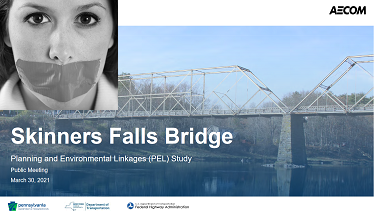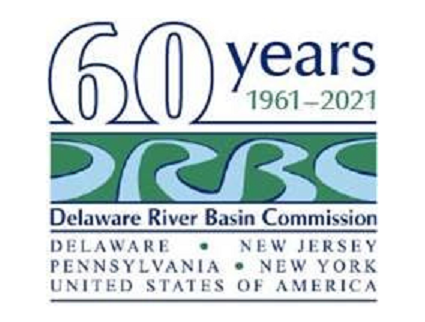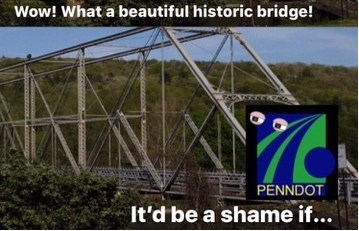
My Rejection of the Milanville Bridge Purpose and Needs Statement
January 3, 2022
Latest on the DRBC Frack Ban Rules
January 26, 2022The Upper Delaware Council (UDC) wrote a letter to PennDOT, dated April 22, 2022, commenting on their Planning and Environmental Linkages (PEL) Study for the Skinners Falls Bridge. In this letter, the UDC expressed strong support for the restoration of the historic Skinners Falls Bridge.
The letter below contains the UDC’s comments to PennDOT on their Purpose and Need document for the Skinners Falls Bridge. The UDC again expressed strong support for the preservation of this landmark structure (download this letter as a pdf).
DCS has also written to PennDOT, challenging their studies regarding the Skinners Falls Bridge and expressing strong support for its rehabilitation.
January 6, 2022
Susan Williams, Project Manager, Senior Civil Engineer Supervisor Transportation
Pennsylvania Department of Transportation
RE: Skinners Falls, NY-Milanville, PA Bridge Draft Purpose and Need Document
Dear Ms. Williams,
The Upper Delaware Council (UDC) expresses disappointment in the draft Purpose and Need Statement that PennDOT released on Dec. 8, 2021 with comments due by Jan. 8, 2022, which we find to be subjectively skewed against rehabilitation of the existing 1902 bridge through faulty assumptions and glaring omissions.
The Purpose and Need document’s intent is to establish a rationale for the proposed transportation improvement project and outline the facts that justify it. As stated on your comment form, it “will drive the process for alternatives consideration, inform the environmental analysis and support the alternative selection process.” Therefore, its contents and tone will play a critical role in decision-making over the fate of the Skinners Falls-Milanville Bridge that has been indefinitely closed to all usage since October 16, 2019.
Our first complaint is with the one-sentence draft Purpose, which reads: “The purpose of this project is to provide a safe and efficient crossing of the Delaware River at Skinners Falls for cars, trucks, emergency response vehicles, bicyclists, and pedestrians.”
It is highly presumptuous to include “emergency response vehicles” as a definitive Purpose component. The document later states that local emergency response vehicles weigh in the range of 15-31 tons for certain fire trucks. Considering that the single-lane bridge was constructed with a 9-ton weight limit, reduced to a 7-ton posting in 2007 and further downgraded to 4 tons in 2013, declaring that category of vehicle as a required use appears to set an unachievable standard of inadequacy for the bridge’s restoration to its original capacity from the very first sentence. However, note that when this project’s Planning and Environmental Linkages (PEL) public survey asked the question, “Beyond your personal usage, what types of vehicles/users need to have access to the bridge to meet local needs?”, respondents prioritized: 1. Personal cars or trucks; 2. Pedestrians; 3. Bicycles; 4. Ambulances; and 5. Small Delivery Vehicles. The three types of usage least selected were: 6. Recreational Vehicles/Boat Trailers; 7. Large Trucks/Fire Trucks/Tractor Trailers; and 8. Buses. Clearly not every possible use of this bridge is deemed appropriate or necessary for this location served by weight-posted roads. Emergency responders in the Upper Delaware River Valley have made reasonable accommodations over the bridge’s 118-year existence to use modern two-lane concrete alternatives at short distances away in Narrowsburg and Cochecton rather than this 13-foot-wide, timber plank deck crossing.
The draft document offers these three Needs statements:
- The Skinners Falls Bridge is currently closed to traffic due to its condition, which limits efficient access for residents, businesses, and recreational users.
- Emergency response is negatively affected by the absence of a functional bridge in the vicinity of Skinners Falls.
- The Skinners Falls Bridge does not provide adequate accommodations for pedestrians, bicyclists, and recreational users in the area.
It states that all public feedback received via the March 30, 2021 virtual public meeting attended by 143 people, the survey conducted from March 31-June 1 with 286 respondents, and the unknown number of project hotline calls, email messages, and comment letters was incorporated into the development of these Needs, yet no comprehensive summary document has been offered for review. Instead, each of the draft Needs is elaborated on with cherry-picked information to support them.
The Purpose and Need document does not indicate that the highest number of recurring themes expressed by the public were: “restore/rehabilitate the bridge” (104); “bridge is a historic resource” (78); “river crossing required at this location” (66); and “quality of life; aesthetics of the area” (63). Its traffic calming effect from the absence of large trucks, and the bridge’s value for recreation and tourism were also strongly supported.
The document merely acknowledges in one paragraph of the Introduction/Background section that “The Skinners Falls Bridge has cultural significance to the local community and larger historic preservation community.” It references the bridge’s listing on the National Register of Historic Places, its location within the Upper Delaware Scenic and Recreational River – which it incorrectly states was designated as a unit of the National Park Service in 1968 (correct date is 1978) – and that the NPS cites this bridge as a contributing element to the Upper Delaware’s Cultural Outstandingly Remarkable Values.
Given the rare existence of pin-connected Baltimore truss bridges today, its qualification for state and national historic recognition, the story it tells, the visitors it attracts, the uniqueness of its ornamentation, and its perfect fit into the rural setting, we feel that the historical and cultural significance of the Skinners Falls-Milanville Bridge rises to the level of a Need for protection.
The document states that traffic counts have consistently identified vehicles in excess of the posted weight limit crossing the bridge despite the “headache” bars installed in 2016 to restrict vehicles over 8.5 feet tall. It indicates, “Regular usage of the bridge by overweight vehicles demonstrates a need to provide a crossing that is suitable for vehicles over ten tons.”
It is patently absurd to conclude that this illegal activity in any way warrants a redesign of the bridge. Instead of conceding to bad behavior, the problem must be addressed through other means such as increased enforcement and camera surveillance. That statement again appears to influence against the concept of historic rehabilitation, yet we remind you that a 2014 PennDOT feasibility study before this PEL Study had recommended full rehabilitation of the bridge to 10-tons.
While we absolutely agree that the Skinners Falls-Milanville Bridge is important to the local economy, we disagree that commerce would suffer any negative impacts by keeping the bridge “as is” since no major industry currently relies on crossing it. To the contrary, the picturesque historic bridge is a special added amenity for the campground, livery businesses, general store, gas station, and Bed and Breakfast inn that operate in the immediate vicinity.
Regarding emergency services, the National Park Service (NPS) is acknowledged as the primary responder for river rescues and its vehicles fit within the 9-10 ton weight postings. Ambulances average 5-7 tons. Most firefighters in this area respond directly to the scenes of emergencies using their personal vehicles. In discussing the Narrowsburg Fire Department’s occasional mutual aid service to the Milanville vicinity, the document states, “The restricted bridge crossing at Skinners Falls forces NFD to utilize River Road, which has narrow lanes, tight curves, and poor sight distance, as their primary response route to Pennsylvania for full-weight trucks…”. We point out that the 10-ton posted River Road would still have the same travel challenges if the Skinners Falls Bridge consisted of a new 40-ton structure. While the speed of a response is obviously important, so too is the safety of the individuals in the vehicles. If this crossing was considered that critical for emergency response, it presumably would have been targeted for immediate reopening or replacement by the NY-PA Joint Interstate Bridge Commission.
Lastly, the Purpose and Need document states that “The Skinners Falls Bridge, in its current condition, does not provide access across the river for recreational vehicles and trailers for recreational boating, fishing, camping, and shopping.” The previously referenced survey results debunk the idea that this is considered to be an issue that needs fixing. It states, “Additionally, the bridge, when open to traffic, did not provide adequate bike and pedestrian accommodations.” The term “adequate” is not defined. As a single-lane bridge with timber running boards, it’s true that there is no sidewalk or designated bike lane; however, there is easy sight distance for the 466.9-feet length of the bridge and clearance to move out of the way of the one oncoming vehicle able to cross at any given time. Therefore, we regard this as potentially prejudicial and a non-issue.
As a member of the Skinners Falls-Milanville Bridge Project Advisory Committee and a Section 106 Consulting Party, the UDC reiterates its opposition to any alternative to eliminate this crossing or to replace it with a standard-issue new bridge. We understand this rare design to be one of only three such truss types among 135 highway bridges owned by PennDOT that has not been demolished as of 2019. “Minimization and mitigation of cultural and environmental impacts” such as erecting a plaque to memorialize this historic bridge would pale in comparison to the opportunity to save this treasured historic gem that we believe adequately fulfills the transportation needs of the people and places that it serves.
The draft Purpose and Need Statement must objectively reflect the true will of public input and information gathered from the study.
Sincerely,
Andrew Boyar,
UDC Chairperson




